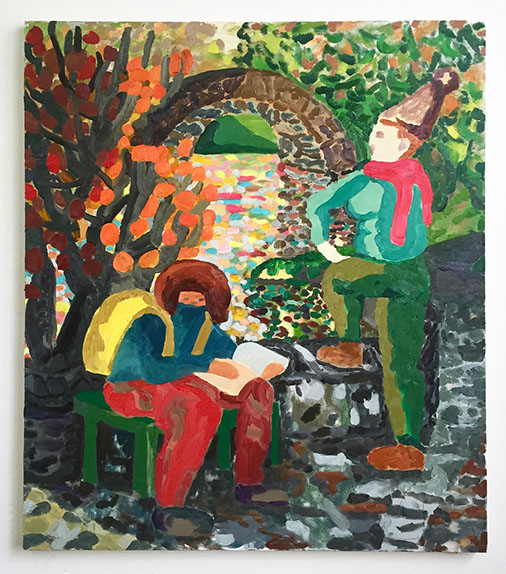
In the Park, 2015
oil on canvas
40 x 46 inches
Polly Shindler with Lauren Collings
Scott Robinson asked me to interview Lauren Collings for Painting is Dead, with no idea that she is to be one of four artists exhibiting in the next show at Trestle Projects in Gowanus –where I am a resident curator. I guess my admiration was palpable. I went to visit Lauren Collings at her studio in the Brooklyn Fire Proof building in Bushwick on the coldest possible day in February.
Polly Shindler: You seem to use location or travel as a source of inspiration. You talked about Rome and "The Flag" pieces. Is travel a must for your process or if you’re not traveling, do you use NYC as an inspiration?
Lauren Collings: Travel is not a must but it’s definitely a wonderful experience and Rome has been an amazing inspiration. It was the first city I went to outside of the US. It was completely overwhelming. I was in high school with art teachers. Steve Baris was one of the organizers of the trip, and he was a wonderful early influence on my development as an artist. He is an artist as well, living and working in the Philadelphia area, and taught some of my art classes in high school. He had already spent time in Rome so he knew the city very well, which made it a really great experience. I was also studying Latin at the time so I saw all this Latin written everywhere and I was just completely blown away by that. The ancient time mixing with contemporary, everyday living. Right now I think about Italy a lot and consider maybe living there one day. The residency I did recently was in Otranto so those "Flag" pieces were from drawing while I was there. But during that trip I did go back to Rome and I think this piece here is actually “Roman.” It’s called Eventually and when I titled it, it was about the layers of history that eventually build up to this sort of mess that is Rome, an absolutely wonderful mess. My husband is really funny. He’s like “the poor dears, they just have too much on their hands.” All the incredible architecture, churches, paintings, sculpture. So yes, the title was about that experience a little bit.
PS: It’s a product of being somewhere with so much history. Do you feel that way about New York City at all?
LC: Definitely. It’s overwhelming, it’s constant. It’s too much to handle because you see everybody walking down the street they’re coming from a different place, different origins, different fashion, different colors just on their bodies.
PS: Do you think it’s people versus place?
LC: The city has a super intense identity that you feel on an emotional level. It’s tough walking through the streets every day. It’s exhausting. It’s amazing. It’s everything all the time. I find that I do a lot of sketching. I look for little places to rest and sketch like at a coffee shop. I try to catch these little moments and then the next thing happens. And it’s just like a constant flow. The pace is really exciting. I love it.
PS: But eventually, you’d like to calm it down. Your paintings evoke a quiet and solitude seemingly unnatural in New York City. But newer paintings display a serious investment in people watching, a part time job for most New Yorkers. But you do find those quiet times and your sketches are made somewhere rowdy, but then you can bring them in here [the studio]. You make them personal and your own.
LC: I’m a very quiet person so I think that just comes from who I am.
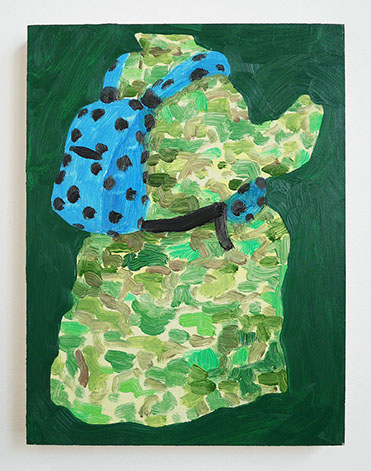
Coat and Backpack, 2014
oil on panel
9 x 12 inches
PS: You’re like a scientist, taking little samples from around the city and bringing them back and making them.
LC: Yeah I really like that idea.
PS: How do you categorize your work –is it important to? You seem to have one foot in abstraction, one in figuration. You really seem like someone who is riding that line and enjoying it. Do you feel the need to reconcile this dichotomy?
LC: I do and I don’t. I make what I’m feeling at the time. And it can be very uncomfortable because I realize that certain things don’t actually fit together when you look from a distance. That’s something I just plow through and decide that I’m going to ignore because there are certain things I do that give me such great pleasure. Like still lives or drawing. Some of the drawing is really awkward and terrible and a mess. You have to try to keep going and if it’s really a mess it’s actually worth figuring out, a fun problem to have. But it can be uncomfortable. The figurative work is more recent and I’m not really sure how to feel about it yet, so it’s like a work in progress. The abstract work I’m doing is based on the figurative.
PS: Like this piece (Shade) I could easily make something up as to what that is and I’m sure it comes from somewhere but it’s not pure abstraction, but is anything? You could probably make sense of anything. It could be a molecule.
LC: Pure abstraction is like Islamic art and pattern and shape and so I like playing with the fact that it could be abstraction but it really is figurative. It’s just taken out of context and it becomes about color and shape.
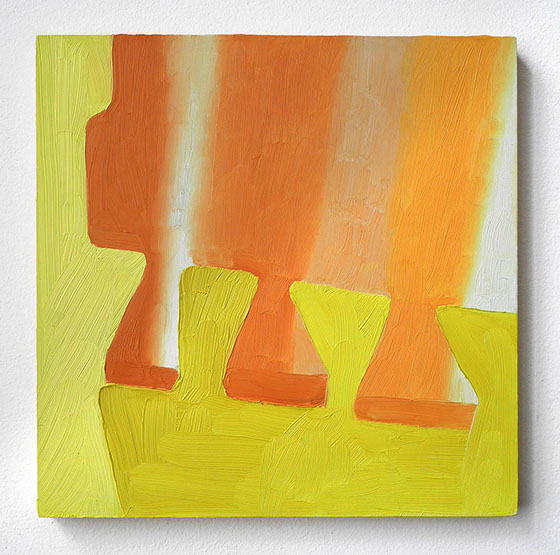
Shade, 2013
Oil on panel
10 x 10 inches
PS: Was Shade preplanned? Is this something you drew ahead of time?
LC: That one came from when I was in Otranto, in Italy. I spent a day or two sketching the in-between spaces of forms that I saw from where I was sitting. It was just line, that was all I was thinking about. And when I sat down to make a painting, I felt uneasy because I didn’t know what I wanted to do with it. I must have had a general idea. That painting has kind of grown on me.
PS: Well it’s puzzling… it actually looks like a puzzle piece. It must take some planning but it also has to be a bit of a surprise, I like that whenever I come in here, I have no idea what I’m going to get, kind of being kept on my toes. The work is so different and I love that. Do you like humor in art?
LC: I massively appreciate it when it happens. It doesn’t always have to happen but I think Ginny’s (Casey) sense of humor is just amazingly outrageous and I love it. I feel I’d want to go there too. I think a sense of humor is the backbone of a lot of what I’m doing in a way. Because I feel like you need a sense of humor to move between the idea of sometimes making just shapes and putting down certain color, keeping things very simple and then at other times going very complex and mushy.
PS: I feel like humor brings the viewer to a painting. If people laugh and they like it and they keep looking, there’s an investment.
LC: Well, I think sense of humor is about noticing anything that falls outside of the agreed upon and usual things we say. It’s like a meta-thing. I get a lot of enjoyment out of going down those roads because if I’m painting representationally, like objects, they come from a certain place. Everything has a certain meaning, so I’m thinking about a million different meanings of all these different objects. Like this still life I just painted, I painted a bag of corn chips and then behind the bag there’s this vessel that I got from my grandmother that has a piece of corn on it. It’s like this corn echo.
PS: I think it makes it relatable. Also in this piece (as yet, untitled), there’s a person with a backpack and that’s also relatable. We see that everyday, we see a freezing person sitting on a bench reading everyday but then what’s that other guy doing?
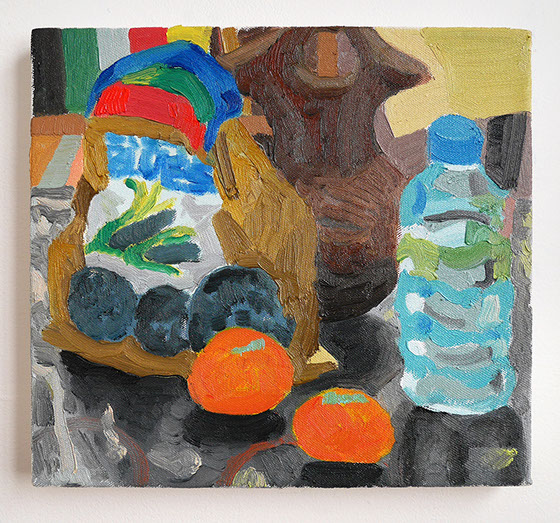
Blues and Cuties, 2015
oil on canvas
10 x 10 inches
LC: He’s like yodeling…
PS: Exactly. It’s just from a totally different era and his positioning is like, ‘what are you doing, where did you come from?’ The scenery is so beautiful that the backpacker just looks completely out of place.
LC: This painting I struggled with for a while. It became an amalgamation of memories from traveling in Japan and walking in Central Park. There are so many beautifully dressed tourists in Japan and I was loving everything they were wearing. I was tempted to do some “selfie stick” paintings. Maybe it’ll happen.
PS: How do you view your work within the New York Scene? Do you think about how you fit in?
LC: I don’t really think about how I fit in because I kind of just have to do my thing. I rely on not fitting in as being kind of a good thing. Although, I do think I fit in in the sense that I have a bunch of friends from the Studio School –Todd Bienvenu, Gili Levy, Becky Yazdan, Ben Pritchard and many others so I feel connected to them and I love talking with them about painting because we all know where we’re coming from. There’s a lot of stuff we don’t have to say. So that’s really wonderful. And I feel I belong in the wider Bushwick community as well. I just love that I’m getting to know these people. And that’s what it’s really about, connecting with people whom I feel genuine excitement and love for the work that they’re doing. I can’t believe I found it.
PS: That said, do you subscribe to the theory that artists would do well to get out of a city saturated with so many artists/painters? Do you feel nourished by the bustling art scene or could you make art anywhere? It sounds like you could do it anywhere.
LC: I don’t know, I think I have my eye on the idea of living somewhere in a rural environment with a studio in the back yard that I could just walk to. That would be amazing, I think I could get so much done. This studio is wonderful but I have to take the subway to get here and sometimes I’m not in the mood.
PS: But it sounds like you’re here a lot.
LC: I am here a lot. I’m here sort of like a full time job. And days that I don’t come here, I’m trying to go to Chelsea more. You find a way into it, a way that is very sustaining. It would help to be in an environment that is conducive to your comfort and being able to think. It’d be hard not having the cultural life that New York offers, but solitude could be good too.
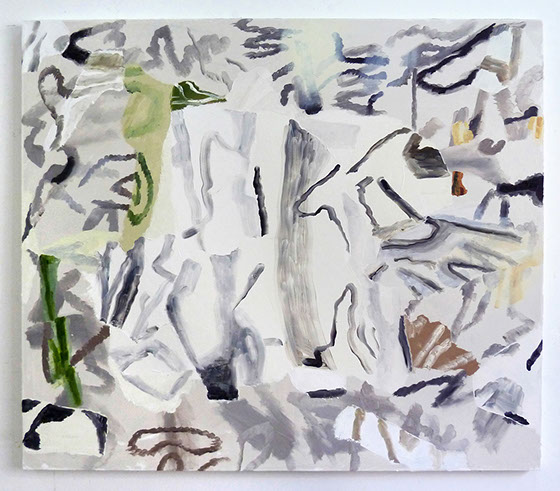
Eventually, 2012
oil on canvas
54 x 62 inches
PS: People aren’t going to come to your studio out in the middle of nowhere on a regular basis.
LC: No, and it’s exciting to be a part of it. Even me, being shy, I don’t really go out a lot, but knowing that it’s there energizes me. It’s nice to know there’s a background hum. There’s a party, and I don’t have to go to it.
PS: Where do you go for inspiration? Are there any museums or galleries in particular that you never miss? Best non-painting show you saw this year?
LC: I always love going to the Met. Whatever’s there is always great and if nothing’s there, it’s great. I really like Rachel Uffner gallery. She has interesting things going on there. I liked seeing Joanne Greenbaum’s work there. I usually just float around and wander and see what I see. I don’t know the names of galleries very well and I like not having to fixate on anything in particular. The one thing I really care about is making connections with people I like. I don’t have to be necessarily, but I’d like to be thought of well in the field of painting someday but other than that, I don’t really care. I want to get to know people who are interesting and that I connect with. I love experiencing stuff that’s not painting specifically. My husband and I just went on a really inspiring road trip. We went through Marfa and saw Donald Judd. It was special and profound. On a different trip we went to this thing in the Mojave Desert called the Integratron. And when I saw Donald Judd’s stuff I thought of the Integratron for some reason, they say that it’s (reading from paper) “The fusion of art, science and magic!” It’s based on Moses’s tabernacle. It’s a very interesting space made completely out of wood and it’s built on some earth-energy-chakra-intersection. I think they wanted to communicate with extraterrestrials. It was built probably
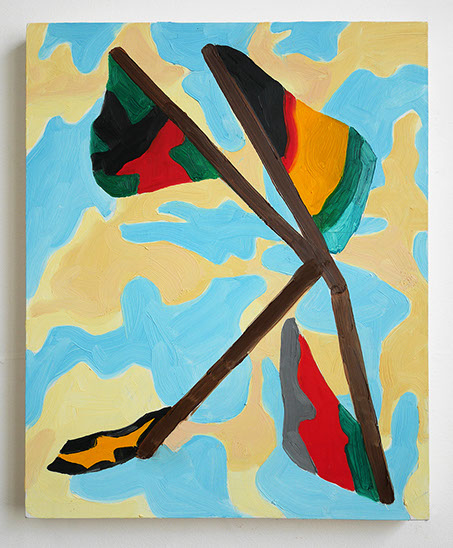
In Flight Navigation, 2014
oil on panel
16 x 20 inches
in the 60s or something. You go there for a sound bath and you lie down and they play these gigantic singing bowls. You just hear all these different tones but it was a pretty cosmic experience because you can feel the sun coming in and you think about how it’s actually coming from the sun out there in the universe like hitting you right now. Also, Ken Price had this retrospective at the Met maybe a year or two ago. I loved it. I was sort of fiddling around with ceramics around that time and making some paintings that were about vessels and those forms. His work is brilliant and funny and very seductive and almost Hollywood. The sculptures are ceramic and they’re painted in these many layers and then he sands them down to get a very vibrant optical mix of color. They’re just really funny, talk about a sense of humor… when you see his drawings, they are so amazing. Ever since I’ve seen that show… how do I make something that is going to have the same vibration that these drawings do?
PS: I spend time in my studio but I spend time doing so many other things, that sometimes seem like goofing off but they really do get
in there and into your “art-brain” somehow. I watch a ton of TV, I read a ton of books. I wanted to know what you do to get out of your “art-mind”. Tell me anything about books, blogs, movies that you enjoy that have nothing to do with art but might inform your art. What kind of media informs your work and what kind is like hitting the reset button?
LC: I read a lot too. I’m in this really great book club. It’s fun to learn about books I would never have heard of otherwise. I have a friend from book club, Megan Twohey, who is a reporter for Reuters. She’s a really interesting person to hang out with. She loves talking about art and the books we read, last year she told me to read Elena Ferrante’s “Days of Abandonment”. Really intense, I loved it. We recently went to go see Lena Dunham interview Miranda July at BAM about Miranda July’s new book, which I just read and it completely blew my mind. I want to read it again. There are so many people interested in gender being a very fluid thing and the relationship in her novel goes through so many different transformations based on gender. I mean it doesn’t have to be about gender at all, but it is. I was working on this painting while I was reading her book. It’s called She Wasn’t on the Beat or Whatever. It’s from a dance party scene in the book where this busty young bombshell is like grinding with an older middle age… there’s this awkward lesbian thing happening… anyway, the painting transformed. That happens with a lot of the books that I’m reading. Lots of titles come from whatever book I’m reading while I’m making the painting.
PS: I think as an artist you’re trying to make sense of what you’re seeing and translating it. Categorizing time is something I’ve been thinking about a little bit. I think that’s what we’re doing even if we never get any recognition. I think it’s about literally making your mark and if it touches somebody, great. And if it doesn’t, that’s the reason why we keep all this stuff (gesturing to Lauren’s storage rack), because it’s like a time capsule of that day or that month when you were really interested in that one book, or that one movie, it like blew your mind and it’s for you.
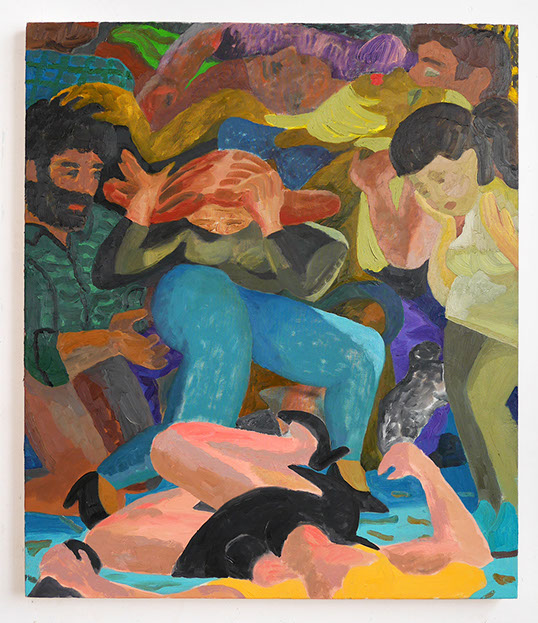
She Wasn't on the Beat or Whatever, 2015
oil on canvas
40 x 46 inches
LC: I think when I first started painting in high school, I remember thinking of a painting as a record of how I spent my time that day. And that’s really kind of fascinating. "Well that was like from 3:30 to 7:30 Thursday night. That’s how I lived my life."
PS: I feel like we all make these choices. You didn’t put the “selfie stick” in for a reason. That you’re not ready or it’s not appropriate for whatever reason. I think a lot about the decisions that we make and the choices. I think about how much can I say with… less is more. I feel like your work has a lot of restraint and I appreciate that.
LC: I like making choices and limiting. As much as you’d want to put in, eliminating 80% of that makes it much more interesting.
PS: Final thoughts?
LC: Lately I’ve been reading a lot about both Philip Guston and Matisse. In one of Philip Guston’s lectures at the Studio School he was saying that he would take a year or so off from painting every now and then and only draw during that time. He wanted the immediacy of drawing to come out in his paintings. Or he wanted his paintings to come out immediately the way his drawing did, like an extension of his body. I like that force and activity that happens when you‘re drawing, you have to improvise. So, I think I’m probably bringing that to my work right now, it’s taught me something and I’m trying it out. And, Matisse is like all I ever need to see to want to make art again. He had the show that was at the Met and then the show at MoMA. How can he not be on your mind? I’ve always cared about him intensely. I read these interviews he did in 1941 and he was talking about how he would spend his time in the studio. If he were drawing a portrait or a studying a figure, he would spend an hour or so drawing the person from a different view than the view in the painting he would make, to get him ready. I found that really interesting. Thinking about multiple spatial views of something before you even consider where you’re going. He would feel the dance as he was painting. He also said something like “in the morning, for the day to go well, I have to wake up feeling like I’m going to kill someone.” Like whoa, I had no idea! I think he just meant he had so much energy he had to wake up that way to feel like he was ready to go and ready to paint. For me it’s more of a slow burn, but I thought that was really great.
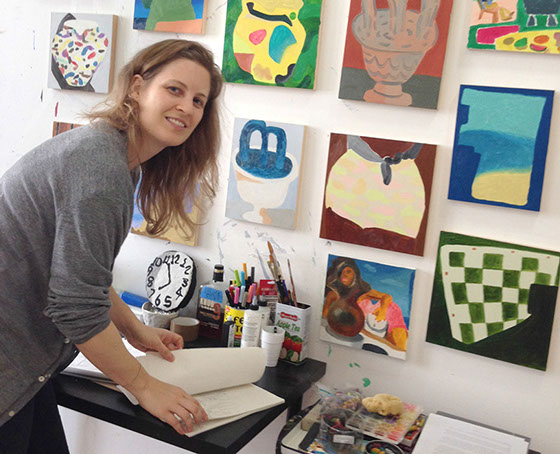
Lauren Collings in studio
Photo courtesy Lauren Collings
Lauren Collings was born in 1981 in Bryn Mawr, Pennsylvania. She received her BFA from Carnegie Mellon University in 2003 and her MFA from the New York Studio School in 2009. She has had solo exhibitions at The Gallery@1GAP, Richard Meier on Prospect Park, Brooklyn, New York and at the Lynchburg College Daura Gallery, Lynchburg, Virginia. Her work has been exhibited in New York City at Brian Morris Gallery, Valentine Gallery, and Parallel Art Space; in Hoboken, New Jersey at Proto Gallery; in Upstate New York at the Wassaic Project; and in Philadelphia at Tiger Strikes Asteroid. In the summer of 2013 she was an artist-in-residence at the BAU Institute, Otranto, Italy and in the fall of 2013 she was an artist-in-residence at the Wassaic Project, Wassaic, New York. She currently lives and works in Brooklyn.
Lauren Collings
Polly Shindler received her B.A. in History from The University of Massachusetts in 2001 and her M.F.A. in Painting at Pratt Institute in Brooklyn, NY in 2011. Recent shows include “Aggro Crag” at BOSI Contemporary, “MsBehavior” at ArtBridge’s Drawing Room, and “Black Foliage” at Nudashank in Baltimore. Polly was named one of “30 Artists to Watch in 2012” by NY Arts Magazine and more recently named Curator in Residence 2014-2015 at Trestle Projects in Brooklyn, NY. She resides in Brooklyn and has a studio in Bushwick.
Polly Shindler
Disclaimer: All views and opinions expressed are those of the authors and do not necessarily reflect the views of the editors, owner, advertisers, other writers or anyone else associated with PAINTING IS DEAD.

